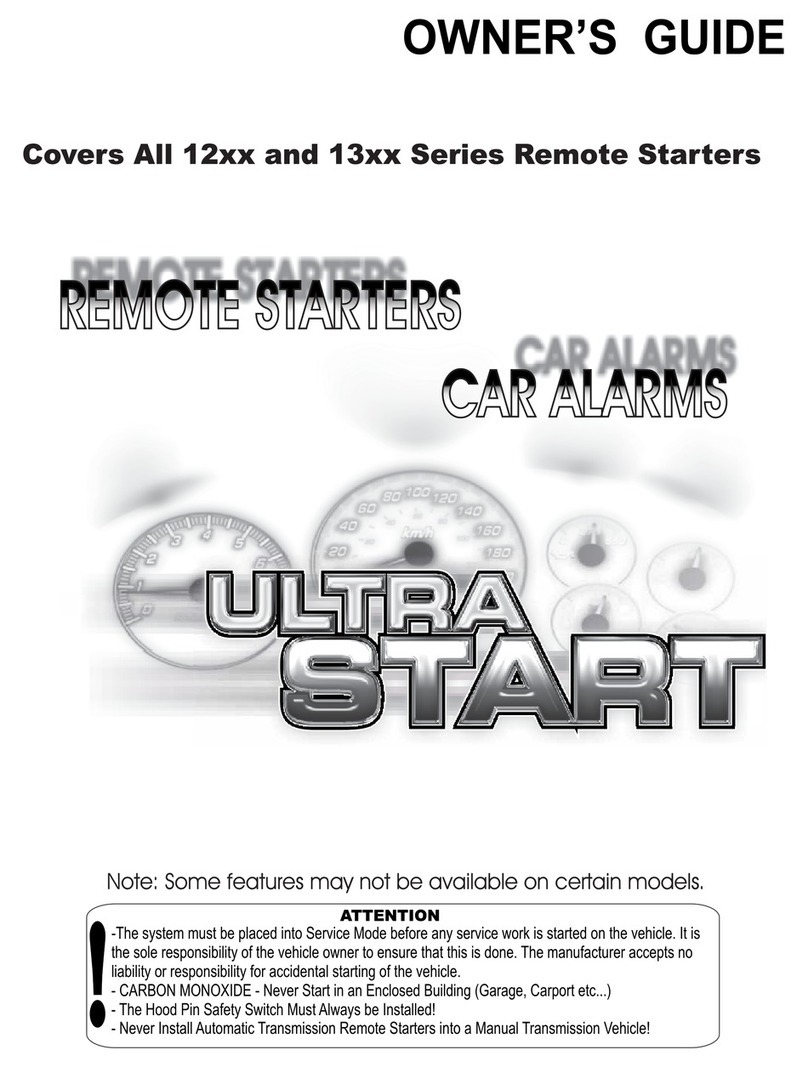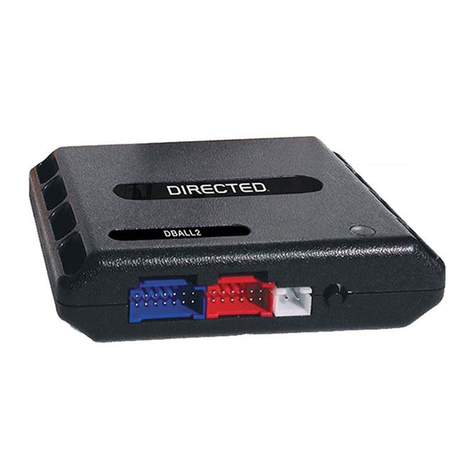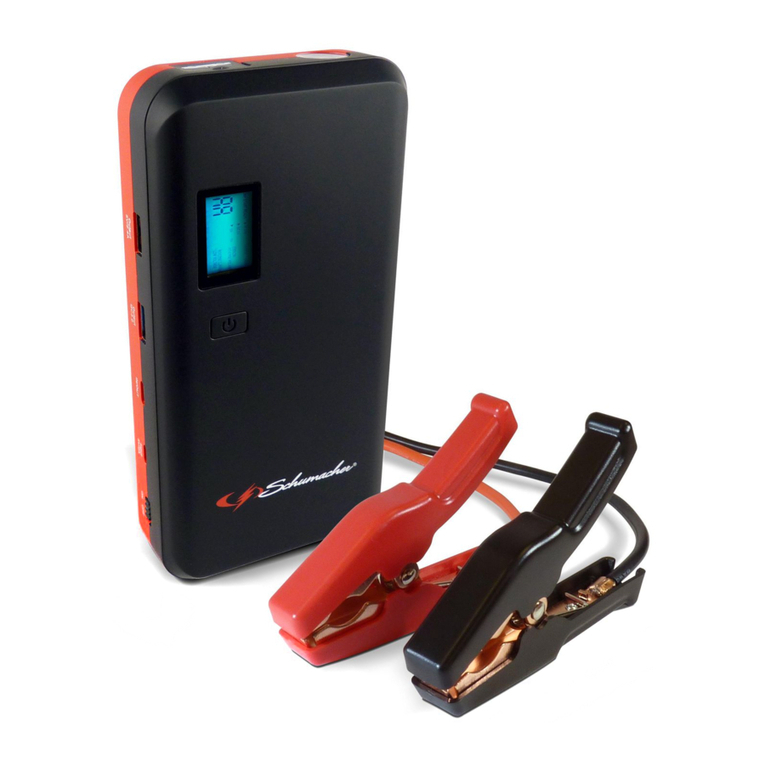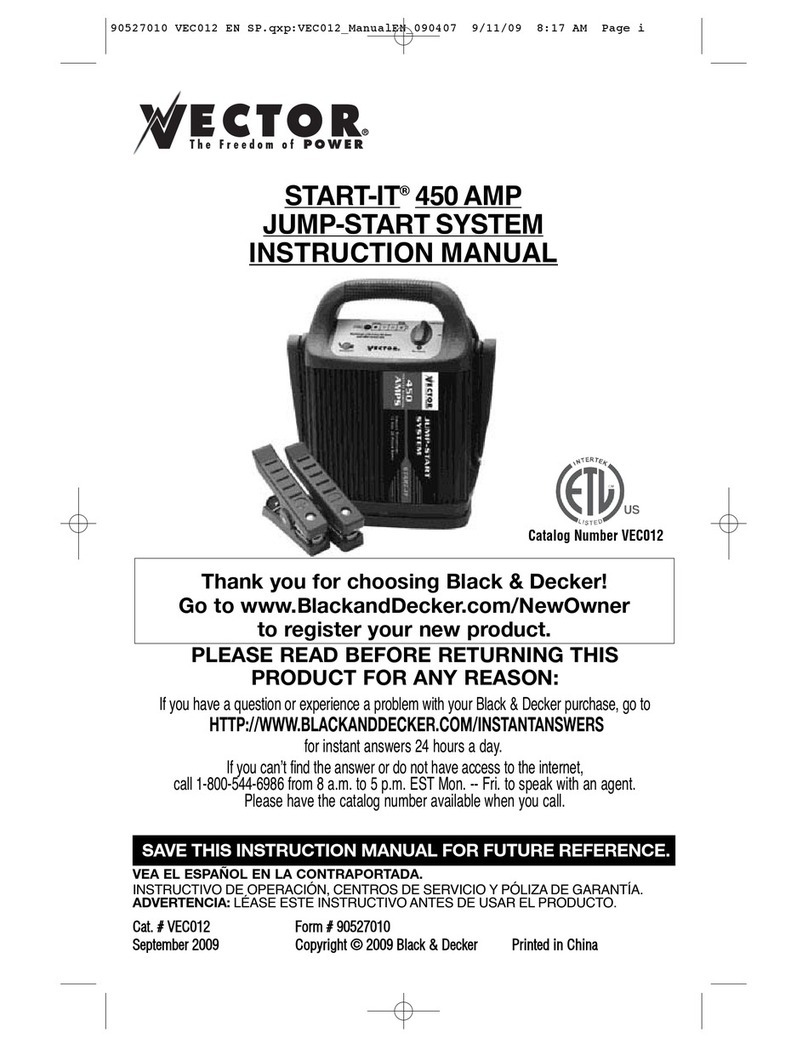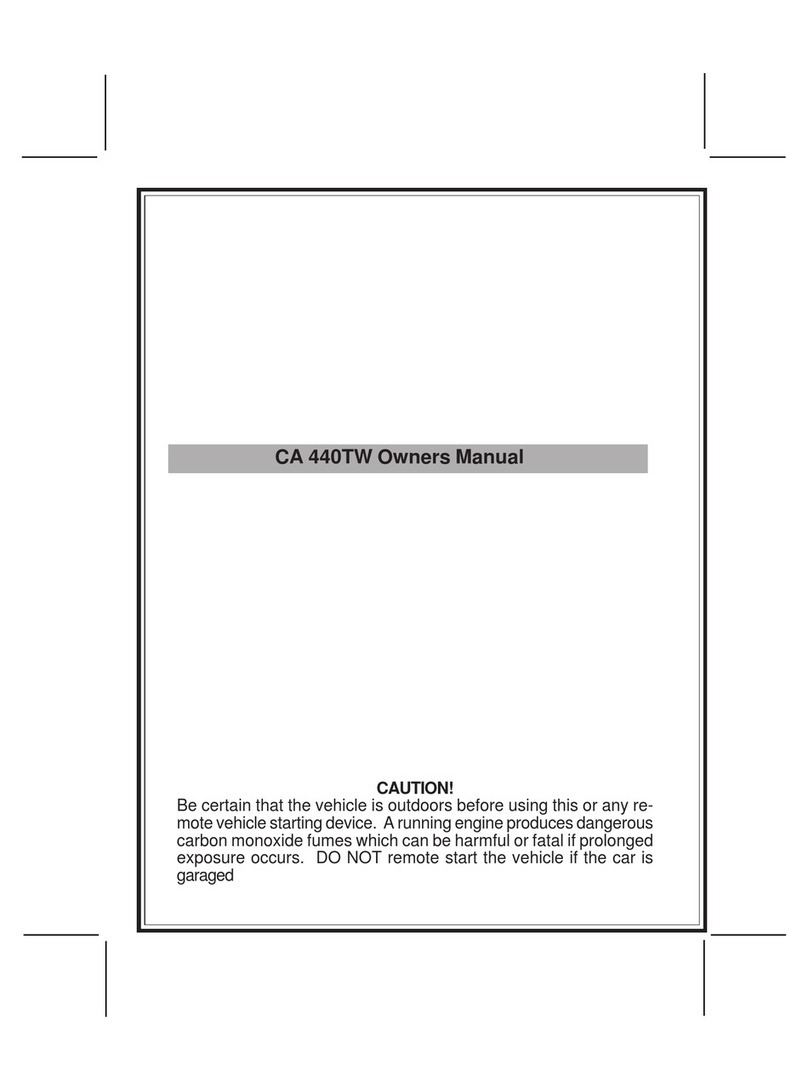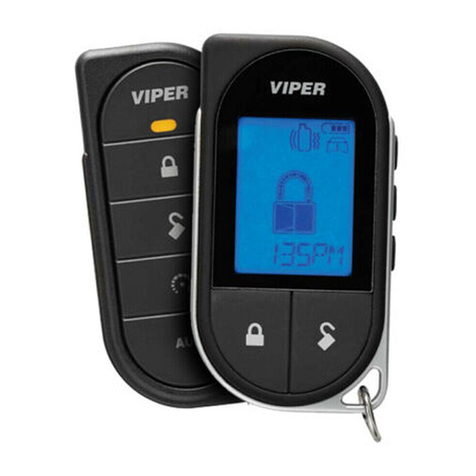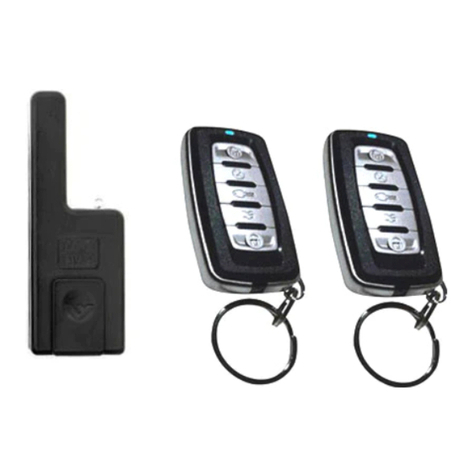Valex FAMILY BANK User manual

1851303
24-11-2016
ATTENZIONE! Prima di usare il prodotto, leggete attentamente le istruzioni per l’uso
CAUTION! Before starting the product, read the operating instructions carefully
AVVIATORE MULTIFUNZIONE LITIO - FAMILY BANK
ISTRUZIONI D’USO
ATTENZIONE! Prima di usare la macchina, leggete attentamente le istruzioni per l’uso
LITHIUM MULTIFUNCTION JUMP STARTER - FAMILY BANK
OPERATING INSTRUCTIONS
CAUTION! Before starting the machine, read the operating instructions carefully

- 2 -
A
B
4
12
14
5
2
3
6
7
8
1
10
10
13
15
11
9
1 8765432

- 3 -
i
SICUREZZA GENERALE PER L’USO DELL’ AVVIATORE
Allo scopo di ridurre il rischio di lesioni personali e di danni
all’attrezzatura, vi raccomandiamo di usare l’avviatore rispettando
sempre le fondamentali misure precauzionali sulla sicurezza.
- Le persone inesperte devono essere opportunamente istruite
prima di utilizzare l’apparecchio.
- I bambini devono essere sorvegliati per sincerarsi che non
giochino con l’apparecchio.
Proteggere gli occhi. Indossare sempre occhiali protetti-
vi quando si lavora con accumulatori al piombo acido.
Evitare il contatto con l’acido della batteria. Nel caso si venga
investiti o si venga a contatto con l’acido, risciacquare immedia-
tamente la parte interessata con acqua pulita. Continuare a ri-
sciacquare fino all’arrivo del medico.
È importante collegare i cavi alle corrette polarità:
Collegare la pinza di carica di colore rosso al morsetto posi-
tivo della batteria (simbolo +). Collegare la pinza di carica di
colore nero al telaio del veicolo, lontano dalla batteria e dal condotto
del carburante.
- Usare l’avviatore in aree ben ventilate. Non tentare di effettuare
avviamenti quando ci si trova in mezzo a gas o liquidi infiammabili.
- Impedire alle pinze nere e rosse di venire in contatto in quanto que-
sto può provocare la loro fusione o quella di altri oggetti in metallo.
Riporre le pinze esclusivamente sugli appositi supporti.
- SOLO PER SISTEMI A 12 VOLT! Usare solo su veicoli con sistemi
elettrici a 12 volt.
- USARE SOLO IN CASO DI EMERGENZA: non usare l’avviatore al
posto della batteria del veicolo. Usare esclusivamente per effettuare
l’avviamento.
- Evitare di lavorare da soli. Nel caso di incidente l’assistente può
prestare aiuto.
Evitare le scosse elettriche. Usare estrema cautela nell’ap-
plicare le pinze a dei conduttori o barre di distribuzione non
isolati. Evitare il contatto corporeo con superfici quali tubi,
radiatori e armadi metallici mentre si sta testando il voltaggio.
- Tenere pulita l’area di lavoro. Le aree ingombre possono provocare
lesioni.
- Evitare di danneggiare l’avviatore. Utilizzare esclusivamente come
specificato in questo manuale.
- Rispettare le indicazioni relative all’area di lavoro. Non usare in
luoghi umidi o bagnati. Non esporre alla pioggia. Lavorare in aree
bene illuminate.
Tenere lontani i bambini: non dovrà mai essere loro consen-
tito di accedere alle aree di lavoro né di maneggiare macchi-
ne, strumenti o prolunghe.
Vestirsi in maniera appropriata. Non indossare abiti larghi o
gioielli che possano impigliarsi in parti mobili. Durante i la-
vori si raccomanda l’uso di abiti protettivi isolati elettricamen-
te nonché di calzature antisdrucciolo. Nel caso di capigliatura lunga
indossare copricapo contenitivi.
- Le riparazioni dell’avviatore devono essere eseguite esclusivamente
da personale esperto altrimenti potrebbero comportare pericoli
considerevoli per l’utilizzatore.
Sostituzione accessori.
- Usare solo accessori di ricambio originali. L’uso di qualsiasi altro
pezzo renderà nulla la garanzia.
- Mantenere in ogni momento un’ adeguata posizione di stabilità
e punti stabili di appoggio. Non spostarsi sopra cavi o strutture
elettriche.
- Effettuare con cura la manutenzione dell’avviatore. Controllarne
periodicamente i cavi e nel caso di danni fare eseguire la riparazione
ad un tecnico autorizzato e qualificato.
- Verificare che non ci siano parti danneggiate. Prima di utilizzare
questo avviatore, controllare attentamente tutte le parti che sem-
brano danneggiate per stabilire se siano in grado di funzionare
correttamente. Controllare che i cavi siano ben fissati all’avviatore.
Si raccomanda di far riparare o sostituire le parti danneggiate da
un tecnico autorizzato e qualificato.
PARTICOLARI AVVERTENZE E PRECAUZIONI SULLA SICUREZZA
PER L’UTILIZZO DELLE BATTERIE AL LITIO CONTENUTE NELL’AV-
VIATORE
L’inosservanza delle seguenti regole può provocare la rottura, il ri-
scaldamento, il rigonfiamento, l’incendio e l’esplosione della batteria
all’interno dell’avviatore:
- Non aprire l’involucro dell’avviatore per nessun motivo.
- Non caricare l’avviatore al sole, in prossimità di fiamme o in con-
dizioni simili.
- Non utilizzare l’avviatore o lasciarlo vicino a stufe, fiamme o in altri
luoghi caldi.
- Caricare l’avviatore utilizzando esclusivamente l’alimentatore per la
ricarica in dotazione con l’apparecchiatura.
- Non gettare l’avviatore nel fuoco o riscaldarlo.
- Non invertire le polarità dei terminali positivo “+” e negativo “-”.
- Non cortocircuitare i terminali dell’avviatore.
- Non forare l’involucro dell’avviatore con punte, non colpirlo col
martello, non calpestarlo.
- Non collocare l’avviatore all’interno di forni, forni a microonde, ecc.
- Non lanciare l’avviatore o provocare forti urti.
- Non manomettere o modificare l’involucro dell avviatore.
- Se durante l’uso, la carica o la conservazione l’avviatore emana
strani odori, si scalda o si deforma l’apparecchiatura non deve
essere più utilizzata.
- Se l’avviatore perde acido o emana strani odori l’apparecchiatura
deve essere subito allontanata da sorgenti di calore o da fiamme
libere.
- In caso di contatto con l’acido della batteria dell’avviatore e la pelle
o i vestiti, subito sciacquare abbondantemente con acqua.
- In caso di contatto con l’acido della batteria dell’avviatore e gli
occhi, subito sciacquare abbondantemente con acqua e contattare
il medico.
Conservare questo manuale.
Il manuale è necessario per consultare le avvertenze e precauzioni
relative alla sicurezza, per le procedure di funzionamento e di manu-
tenzione, per l’elenco dei componenti e per le specifiche tecniche.
Conservare il manuale per eventuali future consultazioni in un luogo
sicuro ed asciutto.

- 4 -
INTRODUZIONE E DESCRIZIONE GENERALE
Uso previsto
Avviatore portatile multifunzione a batteria. L’ideale per chiunque abbia
bisogno di un avviatore d’emergenza. Le sue applicazioni includono
motoveicoli, autoveicoli, imbarcazioni e altro ancora. Pienamente
compatibile con qualsiasi sistema di avviamento a 12 volt.
L’avviatore utilizza BATTERIE AL LITIO; ciò consente al dispositivo
di essere estremamente maneggevole e compatto. L’avviatore multi-
funzione è inoltre dotato di una potente luce a led e di quattro porte
di uscita per alimentare e/o caricare i dispositivi elettronici a 5V/19V.
Descrizione (figura A):
1. Confezione con apertura a libro.
2. Avviatore multifunzione.
3. Pinze di avviamento.
4. Cavo di uscita 19V/3.5A.
5. Cavo di carica con spina jack 12V tipo accendisigari.
6. Cavo adattatore tra porta USB dell’apparecchiatura e le diverse
prese di alimentazione e/o carica dei principali dispositivi elettronici
in commercio.
7. Adattatori in uscita per il cavo (rif. A-4).
8. Alimentatore per la carica.
9. Ingresso per la carica dell’avviatore.
10. Porte USB di uscita 5V/2A
11. Uscita 19V/3.5A.
12. Luci LED.
13. Presa di uscita per le pinze di avviamento (fig. A-3).
14. Tasto ON/OFF per il livello di carica, le porte di uscita (fig. A-10
e 11) e la luce led (fig. A-12).
15. Led di segnalazione dello stato di carica della batteria
interna (rif. 25%, 50%, 75%, 100%)
Simboli (figura B):
1. Leggete attentamente le istruzioni di sicurezza e d’uso
2. Pericolo generico
3. Pericolo esplosione
4. Pericolo sostanze corrosive
5. Pericolo shock elettrico
6. Divieto di usare fiamme libere
7. Obbligo di indossare occhiali protettivi
8. Simbolo che indica la raccolta separata delle apparecchiature
elettriche ed elettroniche. L’utente ha l’obbligo di non smaltire
questa apparecchiatura come rifiuto municipale solido misto, ma
di rivolgersi ai centri di raccolta autorizzati.
INSTALLAZIONE UBICAZIONE DELL’ AVVIATORE
Durante il funzionamento posizionare in modo stabile l’avviatore
appoggiandolo su una superficie orizzontale e piana.
FUNZIONAMENTO
Utilizzo dell’avviatore:
ATTENZIONE: Eseguire le istruzioni seguendo
scrupolosamente l’ordine sotto riportato! Impedire sempre alle
pinze nera e rossa di venire in contatto o di toccare un conduttore
comune!
- Accertarsi che il veicolo o l’imbarcazione da avviare sia spenta.
Prima dei collegamenti togliere la chiave dal blocchetto accensione.
- Collegare prima la pinza rossa POS. (+) al morsetto POS. (+) della
batteria, poi collegare la pinza nera NEG. (-) al telaio del veicolo o
al morsetto NEG. (-) della batteria.
- Collegare lo spinotto delle pinze all’avviatore.
ATTENZIONE: l’inosservanza delle seguenti regole può com-
promettere la durata nel tempo dell’apparecchiatura:
- Portare l’interruttore del veicolo in posizione di avviamento per
un tempo non superiore ai 3 secondi.
- Se l’auto o l’imbarcazione non si avvia, aspettare almeno 20
secondi prima di effettuare un secondo tentativo.
- Se dopo il secondo tentativo, il motore ancora non si avvia
aspettare almeno 2 minuti prima di riprovare.
Dopo l’avviamento e a motore in funzione, seguire rigorosamente la
sequenza di istruzioni:
- Scollegare la pinza nera (negativo) dal veicolo.
- Scollegare la pinza rossa (positivo) dal veicolo.
- Sfilare il connettore dei cavi di avviamento dall’avviatore.
- Riporre i cavi e l’avviatore nell’apposita sede all’interno della cu-
stodia.
Si raccomanda di caricare l’avviatore appena possibile.
Utilizzo dell’ avviatore come dispositivo di alimentazione e/o
carica a 19V:
- Scegliere il cavo di uscita (fig. A-4 o fig. A-6) con il terminale adatto
al dispositivo da alimentare (fig. A-7).
- Inserire il terminale del cavo nella porta di uscita appropriata dell’av-
viatore (fig. A-10 e 11);
- Premere il tasto ON (fig. A-14).
- Inserire l’altro terminale del cavo nel dispositivo da alimentare;
Utilizzo della luce LED
- Mantenere premuto il tasto ON (fig. A-14) per qualche secondo per
attivare la luce led continua.
Premere quindi in sequenza il tasto:
- una volta per attivare la luce intermittente;
- due volte per attivare la segnalazione di emergenza;
- tre volte per spegnere la luce.
CARICA
Importante! Per ottenere le massime prestazioni della batteria, caricare
prima dell’uso, dopo ogni uso e comunque ogni 3 mesi.
È possibile caricare l’unità servendosi di un’alimentazione a 230V usando
l’alimentatore in dotazione,(fig. A-8) o tramite l’apposito cavo con spina
jack 12V (fig. A-5).
Per controllare se la batteria deve essere caricata premere il pulsante
ON/OFF (fig. A-14).
I led (fig. A-15) segnalano lo stato di carica della batteria, crescente
all’aumentare del numero di led accesi:
- un solo led acceso: la batteria è scarica;
- tutti i led accesi: la batteria è completamente carica.
Carica con alimentatore 230V 50HZ
ATTENZIONE: Usare esclusivamente l’alimentatore in dotazione!
- Inserire la spina dell’alimentatore (fig. A-8) in una presa a 230V.
- Inserire successivamente l’apposita spina di uscita nella presa di carica (fig. A-9).
- I led (fig. A-15) si accendono in sequenza quando l’unità è in carica e restano
tutti accesi quando la carica è completa.
- L’avviatore è munito di un dispositivo di controllo che permette di evitare il
sovraccarico della batteria e dell’alimentatore. Lasciare il sistema in carica per
tutto il tempo necessario.
Carica a bordo del veicolo con alimentazione 12VDC:
- Inserire la spina jack accendisigari del cavo in dotazione (fig.A-5) nella

- 5 -
apposita presa a bordo dell’auto o dell’imbarcazione.
- Inserire l’altro terminale del cavo in dotazione nella presa di carica dell’av-
viatore (fig. A-9).
DATI TECNICI
Tipo di batterie:
- batteria al litio-polimero, ermetica, ricaricabile.
Capacità della batteria:
- 9000 mAh
Corrente di avviamento (12V):
- 400A
- (600A di picco)
Luce:
- LED
Prese di uscita:
- due prese USB 5V - 2A
- presa 19V - 3.5A
Caratteristiche:
- interruttore ON / OFF
- interruzione automatica livello di carica
- led di segnalazione livello di carica e finecarica.
- luce led continua, intermittente e di emergenza.
Peso:
- 350g
Accessori inclusi ( fig. A):
- Alimentatore (fig. A-8) 230V 50Hz, 12VDC/1000mA in uscita.
- Cavo di ricarica con jack accendisigari 12V.
- Cavi di collegamento input/output (fig. A-4, A-6).
- Terminali vari (fig. A-7).
SMALTIMENTO
I rifiuti elettrici ed elettronici possono contenere sostanze pe-
ricolose per l’ambiente e per la salute umana; non devono pertanto
essere smaltiti con quelli domestici ma mediante una raccolta separata
negli appositi centri di raccolta o riconsegnati al venditore nel caso
di acquisto di una apparecchiatura nuova analoga. Lo smaltimento
abusivo dei rifiuti comporta l’applicazione di sanzioni amministative.
AVVERTENZA:
Non smaltire la batteria bruciandola. Questo potrebbe causare un’e-
splosione. Prima di smaltire la batteria, coprire i terminali scoperti
con nastro isolante adeguato, allo scopo di evitare i corti circuiti. Non
esporre la batteria a calore intenso o a fuoco poiché questo potrebbe
causare un’esplosione.
GARANZIA
Il prodotto è tutelato a norma di legge contro non conformità rispetto
alle caratteristiche dichiarate purché sia stato utilizzato esclusivamente
nel modo descritto dalle istruzioni, non sia stato manomesso in alcun
modo, sia stato conservato correttamente, sia stato riparato da tecnici
autorizzati e, ove previsto, siano stati utilizzati solo ricambi originali.
In caso di utilizzo industriale o professionale oppure in caso di impiego
simile la garanzia ha validità di 12 mesi.
Per emettere una richiesta di intervento in garanzia è necessario
presentare la prova di acquisto al rivenditore o ad centro assistenza
autorizzato.
DICHIARAZIONE CE DI CONFORMITÀ
La ditta sottoscritta:
Via Lago Maggiore, 24
36015 SCHIO (VI) ITALY
Dichiara sotto la propria responsabilità che il prodotto:
PRODOTTO: Avviatore multifunzione Litio
MODELLO TIPO: FAMILY BANK
COD. PRODOTTO: 1851303
E’ conforme ai requisiti di sicurezza e salute della direttiva:
2014/30/CE, 2011/65/CE
SCHIO, 11-2016
Un procuratore
SMIDERLE STEFANO

- 6 -
g
GENERAL SAFETY USER INSTRUCTIONS FOR THIS STARTER
In order to reduce the risk of personal injury and damage to
equipment, it is highly recommended to comply with all essential
safety measures and precautions when using the starter.
- Inexperienced and untrained personnel should be properly
instructed before using the appliance.
- Children must be supervised to prevent them from playing with
the appliance.
Protect the eyes. Always wear protective goggles when using
acid lead accumulators.
Avoid contact with battery acid. If an operator should be
sprayed or come into contact with the acid, rinse the
relative parts immediately under clean running water.
Continue to rinse the area until the physician arrives.
It is important to connect the cables with the poles in the
right direction:
First connect the red clamp to the positive terminal on the vehicle
battery (+ symbol). Connect the black clamp to the vehicle chassis, at
a distance from the battery and the fuel pipe.
- Use the starter in well ventilated areas. Do not attempt to use the
starter when there is gas or inflammable liquids in the vicinity.
- Make sure that the black and red clamps never come into contact
with each other as this could cause them to fuse together or with
other metal objects. Return the clamps to their respective housing.
- FOR 12 VOLT SYSTEMS ONLY! This device is destined for use on
vehicles running on 12 Volt electrical systems only.
- USE IN EMERGENCY SITUATIONS ONLY: do not use the starter
instead of the vehicle battery. Use it during start-up operations only.
- Do not work alone. If there is an accident, the assistant can be of
aid to the operator.
Prevent electrical shocks. Be very cautious when applying the
clamps to non-insulated conductors or bus bars. Avoid all body
contact with surfaces of tubes,radiators, and metal power
substations whilst testing the voltage.
- Keep the work area clean at all times. Untidy cumbersome areas
can lead to injuries.
- Protect the starter appropriately from all possible damage. It must
only be used as indicated in this Instruction Manual.
- Ensure compliance with the indications in the work area. Do not
use in humid or wet facilities. Never leave it out in the rain. Always
work in well lit areas.
Keep out of reach of children: they must never be allowed
to access work areas or handle any machines, instruments
or extensions.
Always wear suitable clothing. Never wear baggy clothing
or jewellery that can get caught up in moving parts. During
all operations, the use of electrically insulated protection
clothing and non-slip boots must be worn at all times. Persons
with long hair must tie it back and wear a hair net.
- Only experts are allowed to do repair work on the starter as it
involves significant risk levels for inexperienced workers.
- Replacing parts and accessories. When performing maintenance
operations, replace with identical spare parts only. Use of nonoriginal
spare parts invalidates all warranties.
- Make sure that the device is always positioned in a stable and well
supported manner. Never climb over cables or electrical structures.
- Careful attention must be paid during maintaining work on the
starter. Check the condition of cables on a regular basis and if any
damage is detected, have the same repaired by an authorised and
qualified technician.
- Check there are no damaged parts. Before using this starter, carefully
check that all seemingly damaged parts and assess whether or
not they can operate correctly. Check that the cables are securely
fastened to the starter. Remember that only authorised and qualified
technicians are allowed to repair or replace damaged parts.
SPECIAL WARNINGS AND SAFETY PRECAUTIONS ON
THE USE OF THE LITHIUM BATTERIES INSIDE THE STARTER
Failure to observe the following rules can cause breakage, overhea-
ting, bulging, fire outbreak or explosion of the battery inside the starter:
- Never open the starter casing under any circumstances.
- Do not charge the battery in direct sunlight, near flames or in similar
conditions.
- Do not use the starter or position it in the vicinity of heaters, near
flames or in other hot areas.
- Only use the charger supplied with the device to charge the starter.
- Do not throw the starter into a fire or heat it up.
- Do not invert the positive “+” and negative “-” connection polarities.
- Do not short-circuit the starter terminals.
- Do not perforate the starter casing with drill bits, do not hit it with
a hammer or stand on it.
- Do not position the starter inside stoves, microwave ovens etc.
- Do not throw the starter or cause high impacts.
- Do not modify or tamper with the starter casing.
- Refrain from using the starter if it emits strange smells, heats up or
deforms during use, charging or storage.
- If the starter emits strange smells or leaks acid, immediately move
the device away from any heat sources or free burning flames.
- In case of contact of the starter battery acid on the skin or clothing,
rinse with copious amounts of water.
- In case of contact of the starter battery acid with the eyes, rinse
immediately with copious amounts of water and call a doctor.
Keeping this manual.
The manual should be read, paying attention to all the warnings and
safety precautions to be taken when using and maintaining the device,
the list of components and all technical specifications.
Please keep this manual in a secure and dry place for future reference.

- 7 -
I
NTRODUCTION AND GENERAL DESCRIPTION
Intended use
Multi-functional, portable, battery-powered starter. Ideal for anyone
needing an emergency starter. Its applications include use on motorcycles,
automobiles, boats and many more. Fully compatible with any 12volt star-
ter system.
The starter uses LITHIUM BATTERIES; this makes the device extremely
compact and easy to handle.
The multi-functional starter is also equipped with a powerful LED light and
four outputs to power and/or charge 5V/19V electronic devices.
Description (figure A):
1. Book type pack.
2. Multifunctional starter.
3. Starter clamps.
4. 19V/3.5A output cable.
5. Charger cable with cigarette lighter type 12V jack plug.
6. Adaptor cable to connect the USB port on the device to various power
and/or charge inputs on the main commercially available electronic
devices.
7. Output adaptors for the cable (fig. A-4).
8. Charging power unit.
9. Starter charging input.
10. Output USB 5V / 2A
11. 19V/3.5A output.
12. LED lights.
13. Starter clamps outs (fig. A -3).
14. ON/OFF switch for the charge level, the output ports (fig. A-10 and 11)
and the LED light (fig. A-12).
15. Internal battery charge status indicator LED.
Simboli (figura B):
1. Carefully read the safety instructions and operating instructions
2. General hazard
3. Danger of explosion
4. Danger of corrosive substances
5. Danger of electric shock
6. Free flames are forbidden
7. Eye protections must be worn
8. Symbol indicating separation of electrical and electronic appliances for
refuse collection. The user is not allowed to dispose of these appliances
as solid, mixed urban refuse, and must do it through authorised refuse
collection centres.
INSTALLATION POSITIONING THE STARTER
When using the starter, position it on a horizontal, flat and stable surface.
OPERATING INFORMATION
How to use the starter:
WARNING: follow these instructions meticulously, and
always in the order given below!
Always prevent the black and red clamps from touching
each other or a common cable!
- Make sure that the vehicle or boat to be started is switched off (switch or
ignition key in the OFF position).
- Connect the red clamp POS. (+) to the battery terminal POS. (+), then
connect the black clamp NEG. (-) to the vehicle chassis or the battery
terminal NEG. (-).
- Connect the plug of the starter tongs.
WARNING: failure to follow these rules may compromise the
operating life of the device:
- Turn the vehicle ignition to the start position for no more than 3 se-
conds.
- If the vehicle or boat does not start, wait at least 20 seconds before
trying again.
- If the vehicle or boat still does not start, wait at least 2 minutes before
trying again.
After a successful start, with the engine running, follow the sequence of
instructions below with great care:
- Disconnect the black clamp (negative) from the vehicle.
- Disconnect the red clamp (positive) from the vehicle.
- Remove the starter cable connector from the starter.
- Replace the cables and the starter in their seats inside the case. It is highly
recommended to recharge the starter as soon as possible.
Use of ‘starter as the feeding device and / or charging 19V:
- Select the output cable (fig. A-4 or fig. A-6) with the terminal suitable
for the device to be powered (fig. A-7) according to the required voltage/
current;
- Insert the cable terminal into the appropriate output port on the starter
(fig. A-10, 11);
- Press the ON button (fig. A-15).
- Insert the other cable terminal into the device to be powered.
Using the LED lights
- Press and hold the ON button (fig. A-14) for a few seconds to enable the
continuous LED light function.
The press the button in the following sequence:
- once to start the blinking light;
- twice to start the emergency signal;
- three times to switch the light OFF.
CHARGING
Important! To achieve maximum battery performance, always charge be-
fore use, then after every time it is used and, in any case, at least every 3
months.
The unit can be charged using a 230V power supply using the power supply
adapter supplied, (fig. A-8) or using a 12V cable with a jack plug (fig. A-5).
Press the button (fig. A-14) to check whether the battery needs charging.
The LEDs (fig. A-15) indicate the charge status of the battery, which light
up as the status increases:
- one LED only: low battery;
- all LEDs are on: fully charged battery.
Charging with 230V 50Hz power supply
WARNING: Use the supplied power supply adapter only!
- Insert the power supply adapter plug (Fig. A-8) into a 230V socket or other
compatible with the network voltage.
- Now insert the relative output plug into the charger socket (fig. A-9).
- The LEDs (fig. A-15) light up in sequence when the unit is charging and
remain on when the unit is fully charged.
- The starter is fitted with a control device to prevent overcharging the battery
and power unit. Leave the system to charge for as long as necessary.
Charging onboard the vehicle using 12VDC power supply:
- Insert the jack plug on the supplied cable (Fig. A-5) into the cigarette
lighter socket in the car or onboard the boat.
- Insert the other terminal of the supplied cable into the starter charge so-
cket (Fig. A-9).
SPECIFICATIONS:
Type of battery:
- rechargeable factory-sealed lithium-polymer battery.
Battery capacity:
- 9000 mAh
Starter current (12V):
- 400 A
- (600A peak)
Light:
- LED
Output sockets:
- two USB sockets 5V - 2A
- 19 V – 3.5A socket
Characteristics:
- ON/OFF switch
- automatic charging level reset switch
- charge level and fully charged indicator LEDs
- continuous, blinking and emergency LEDs
Weight:
- 350 g

WARRANTY
The product is protected by law against non-compliance with the de-
clared characteristics provided it is used only in the manner described
in the instructions, it has not been tampered with in any way, it has
been stored properly, has been repaired by authorized and, where
applicable, have been used only original spare parts.
In the case of industrial or professional use or when using such a
guarantee is valid for 12 months.
To issue a claim under warranty you must present proof of purchase
to your dealer or authorized service center.
DECLARATION OF CONFORMITY
The company:
Via Lago Maggiore, 24
36015 SCHIO (VI) ITALY
Declares, under its own responsibility, that the machine:
PRODUCT: Lithium multifunction jump starter
MODEL: FAMILY BANK
PRODUCT CODE: 1851303
complies with health and safety directives:
2014/30 / EC, 2011/65 / EC
SCHIO, 11-2016
Attorney
SMIDERLE STEFANO
Accessories included:
- Output power unit (fig. A-8) 230V 50Hz, 12 VDC/1000mA.
- Charge cable with 12 V cigarette lighter jack plug.
- Input/output connection cables (fig. A-4, A-6).
- Various terminals (fig. A-7).
DISPOSING OF THE BATTERY
When the starter battery is completely run down it should be sent to
a re-cycling facility. In some countries this is mandatory. Contact the lo-
cal special refuse authority for information on recycling.
WARNING:
Do not burn the battery to dispose of it. This could cause an explo-
sion. Before disposing of the battery, apply insulating tape to the
bare terminals to prevent shorting. Do not expose the battery to
intense heat or fire as this could cause an explosion.
This manual suits for next models
1
Table of contents
Languages:
Popular Remote Starter manuals by other brands
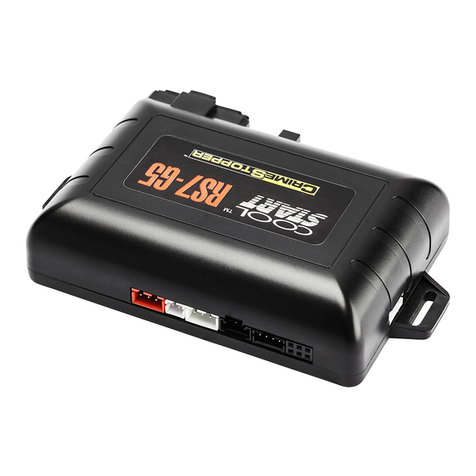
CrimeStopper
CrimeStopper Cool Start RS7-G5 FM operating instructions

Directed Electronics
Directed Electronics Cyber 110XV user guide
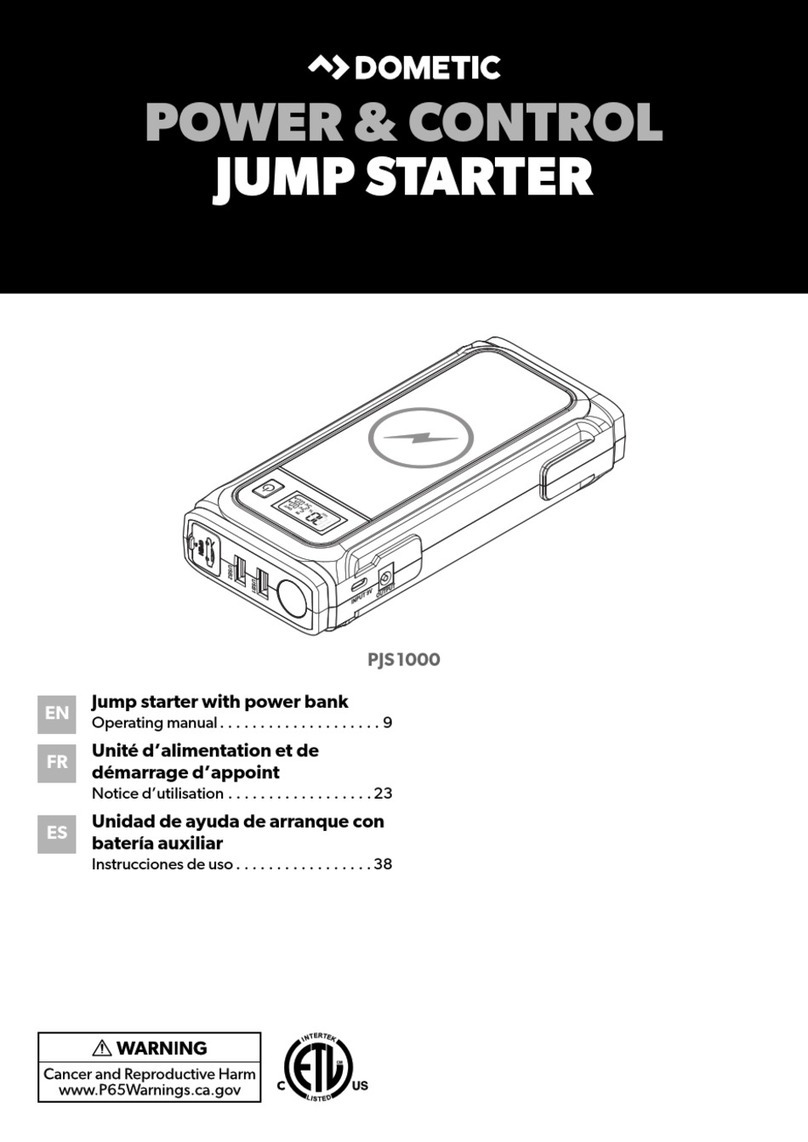
Dometic
Dometic Power & Control PJS1000 operating manual
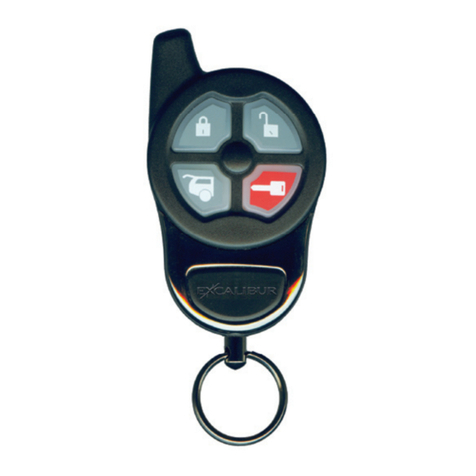
Excalibur
Excalibur rS-350-eDPb Operation guide
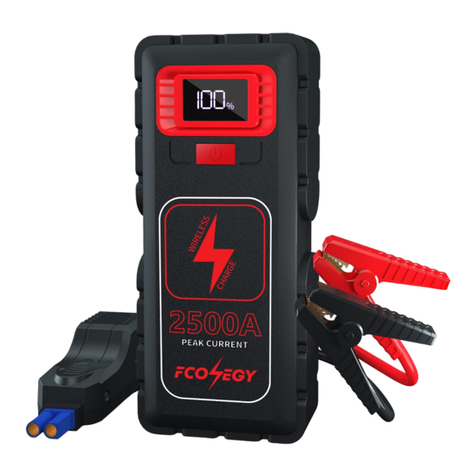
FCONEGY
FCONEGY FC500 user manual
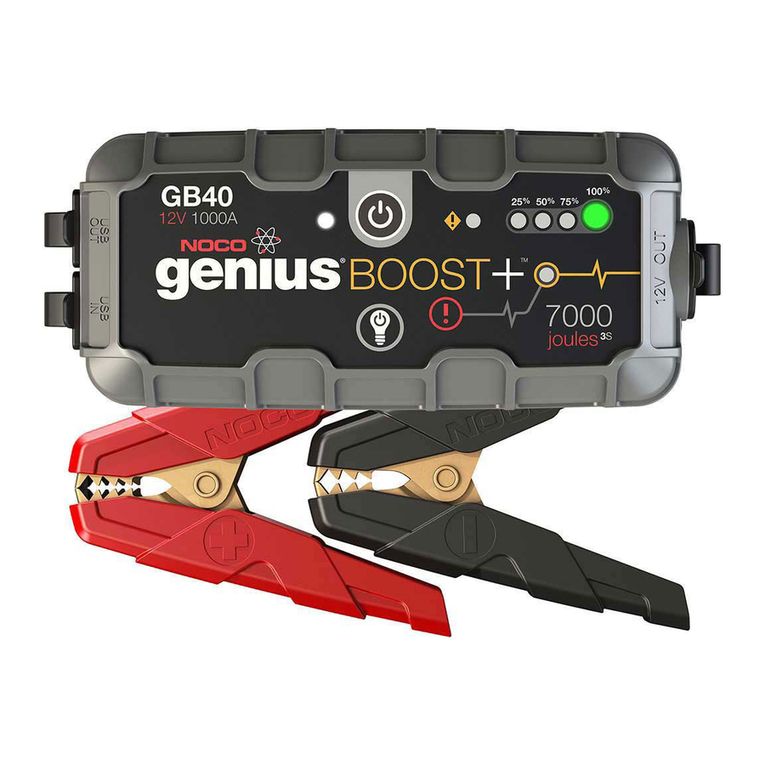
NOCO Genius
NOCO Genius Boost+ GB40 user guide
